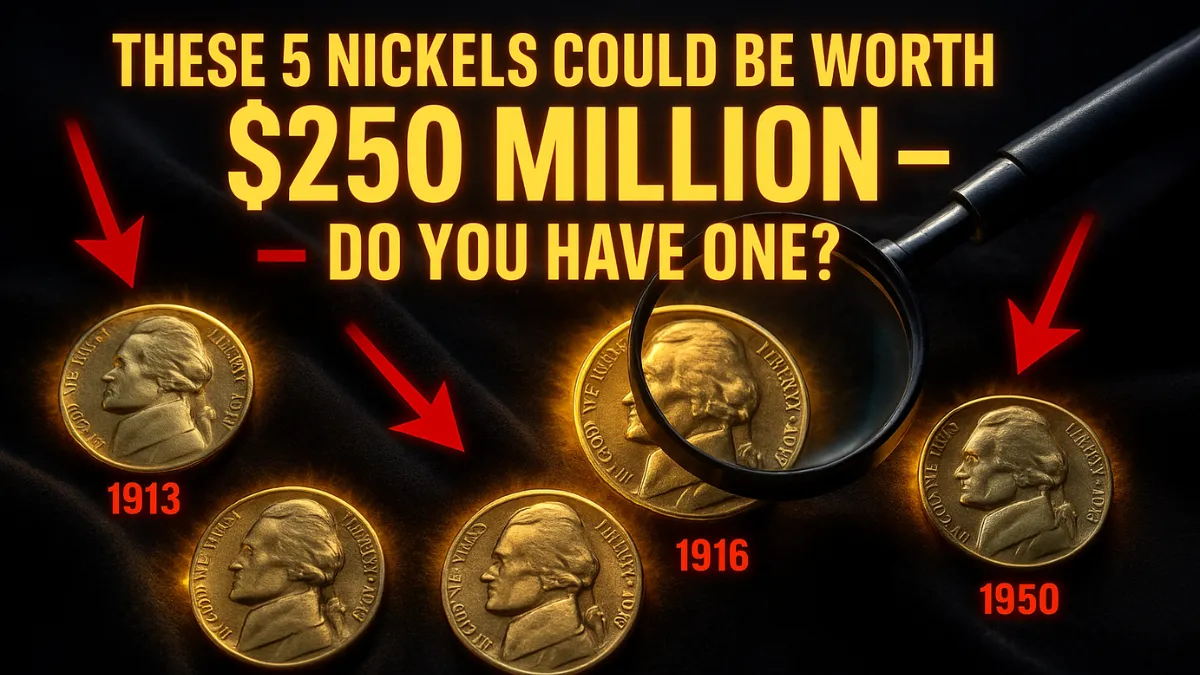Nickels may seem like ordinary coins, but a few of them are worth a fortune to collectors. Some rare U.S. nickels, either because of mistakes during minting or because only a few were made, are now incredibly valuable—altogether worth around $250 million. These coins have interesting backstories, from hidden minting to wartime mix-ups. One of them could even be sitting in your coin jar right now. Let’s explore the top five most valuable nickels and why they are so sought after.
The Rare 1913 Liberty Head Nickel
The 1913 Liberty Head Nickel is one of the most famous and rarest coins in U.S. history. Only five of them were ever created, and they weren’t officially supposed to be made. In 1913, the U.S. Mint switched from the Liberty Head design to the Buffalo Nickel. But a Mint employee—likely Samuel Brown—secretly made five of the old design. These coins are now worth as much as $6.25 million each. One sold for $4.56 million in 2018. Only three are in private hands while two are in museums, making them very rare and highly desired by collectors.
1918/7-D Buffalo Nickel: A War-Time Mistake
The 1918/7-D Buffalo Nickel was made by accident during World War I. At the Denver Mint, a die from 1917 was reused in 1918, and the number “8” was stamped over the “7.” This error is called an overdate and is easy to miss unless you look with a magnifying glass. Fewer than 100 of these coins are known to exist. One sold for $350,750 in 2006, and today, it could be worth over $500,000. The mistake, combined with its rarity, makes it a prized find for coin collectors.
1926-S Buffalo Nickel: Smallest Production
The 1926-S Buffalo Nickel is rare because not many were made. Only 970,000 were struck at the San Francisco Mint, much fewer than other nickels of that time. Many of the ones that were made also suffered from weak or unclear details. That makes well-preserved examples extremely rare. In 2008, one sold for $322,000. Today, top-quality versions can reach $400,000 or even more. Its low mintage and vintage look make it a must-have for Buffalo Nickel fans.
Other Valuable Nickels to Know
Here’s a quick summary of these and a couple more top nickels to keep an eye out for:
| Coin & Year | Unique Feature | Estimated Value |
|---|---|---|
| 1913 Liberty Head | Only 5 made, secret minting | Up to $6.25M |
| 1918/7-D Buffalo | Overdate mistake, Denver Mint | Up to $500K |
| 1926-S Buffalo | Low mintage, San Francisco | Up to $400K |
| 1937-D 3-Legged Buffalo | Missing leg from die polishing | Up to $150K |
| 1969-S Doubled Die | Doubled letters, Jefferson Nickel | Up to $35K |
The 1937-D 3-Legged Buffalo Nickel is another interesting coin. It’s missing one of the buffalo’s legs due to the die being polished too much. The 1969-S Doubled Die Jefferson Nickel is also valuable because the letters appear blurry or doubled—another rare mistake that adds to its worth.
Why Rare Nickels Are Still Around
Even though billions of nickels have been made, some of these rare ones are still out there. Mistakes like overdates and doubled letters often went unnoticed, and the coins ended up in circulation. People have found rare nickels in their loose change, like the 1937-D 3-Legged Nickel. With so many coins still being used, it’s possible you could find a valuable one in an old jar, coin roll, or pocket.
Tips to Spot a Rare Nickel
To check if your nickel is rare, start by looking at the date and mint mark—a tiny letter near the year. A “D” means Denver, an “S” stands for San Francisco, and no letter means it came from Philadelphia. Use a magnifying glass to spot details like doubled numbers, missing parts, or other oddities. For example, on the 1918/7-D, you can see the “7” under the “8.” If you think you’ve found something special, it’s best to have it looked at by a professional coin grader such as PCGS. So next time you handle a nickel, take a closer look—you might be holding a rare treasure worth thousands or even millions.
FAQs
1. How can I tell if my nickel is valuable?
Check the coin’s date and mint mark. Use a magnifying glass to spot unusual features like doubled numbers, missing details, or overstrikes. Rare nickels often have visible minting errors.
2. Are old nickels always worth money?
Not all old nickels are valuable. Coins with rare dates, minting mistakes, or very low mintage are worth more. Common old nickels usually only have face value.
3. What does the “S” or “D” mean on a nickel?
The “S” stands for the San Francisco Mint, and “D” stands for the Denver Mint. These mint marks help identify where the coin was made and can affect its value.
4. Where should I take a rare nickel to get it appraised?
You can have your coin professionally graded by services like PCGS or NGC, or visit a trusted coin dealer or local coin show for an expert opinion.
